At first glance, the best radar detectors seem like an underhanded way to get away with speeding, letting drivers know when they’ve hit an average speed checking point on the highway so they can slow down. Despite the negative (and dangerous) use that people associated them with though, radar detectors can also be used responsibly to help you become a better driver.
It’s easy to lose track of your speed and let it drift a little above the speed limit when you’re doing long stretches of highway driving, so having one of the best radar detectors to help you keep more accurate track of your speed can literally be a life saver. Many models have built in alerts that will trigger if you exceed the speed limit too.
We extensively tested many of the best radar detectors on the market, both by driving around with them and also by digging deep into the specs and features to help you make the best choice. In the end, the Escort Max 360c took our top spot thanks to its long range and ease of use. It also has over-speed alerts to encourage you to drive safely, and we think it’s ideal for both city and highway driving.
1. Escort Max 360c: best overall
Why you can trust Top Ten Reviews
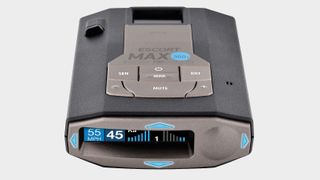
The Escort Max 360c is not cheap, in fact it’s one of the most expensive mainstream radar detectors out there. But the sophisticated balance of long-range sensitivity and effective use of GPS make it the most effective radar detector we've reviewed. If you're someone with a history of traffic citations, this detector is your best option for avoiding expensive tickets. And you don't need to be a radar expert to effectively make sense of it, either.
Escort even provides a ticket reimbursement guarantee, though it only applies to speeding tickets that resulted from a radar gun. In our highway performance test, the Escort Max 360c received an A with one of the longest ranges in each of the five scenarios we tested. While it didn't quite have the range of the Valentine One and the Escort RedLine EX, the range was more than enough to provide you with ample time to adjust your driving habits.
For example, in the straight-ahead test where the radar gun was pointed straight down the road, it still detected the radar two miles away. And this was using a K-band radar gun, which has a shorter range than the X-band typically used in freeway settings. Even in other scenarios, which had the radar gun pointed in various angles, the Max 360c provided one of the longest ranges.
The ease of use with Max 360c is ideal for novices. The controls are clearly labelled, and the display is matched only by other Escort detectors. The alerts are effective, and they automatically mute themselves after the initial voice alert. The built-in GPS automatically connects to the satellite and provides a wide range of features that includes an over-speed alert, which is the best way to avoiding speeding and far better than being detected by a police radar gun. You can take this detector out of the box and use it effectively. It may be pricey, but it’s absolutely worth the money.
- Read the review: Escort Max 360

2. Escort IX: best value
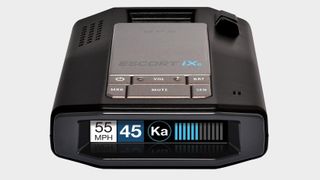
In a side-by-side comparison, the Escort IX looks and performs very nearly as well as the top rated Escort Max 360c. Both feature high-end performance in both highway and city settings. Both feature sophisticated built-in GPS features and exceptional ease of use. The most notable difference is the price – the Escort IX costs much less than the Max 360c.
This is why the Escort IX is our pick for best value in radar detectors. The Escort IX doesn't have directional arrows that tell you where the radar is coming from like the Max 360c, but it’s otherwise designed to improve your driving awareness.
With an adjustable over-speed alert, which uses the built-in GPS to accurately measure your speed, you always know when you've exceeded the speed limit. This is the only fool-proof method for ensuring you don't get a ticket and maintain a high awareness of your driving habits.
In the highway tests, this detector received an A- for performance. While the range wasn't nearly as far as the Max 360c and the Valentine One, it still provided plenty of range in each scenario to safely adjust your driving habits in time to avoid a ticket. For example, the shortest range it recorded was a half mile with radar gun aimed perpendicular to the road.
When the gun was aimed down the road, the range exceeds two miles. The city test was even better, receiving an A using the Auto Lo K and Auto No X sensitivity settings. Both settings use the GPS to automatically adjust the sensitivity as you drive. The faster you drive, the more sensitive the sensors. This provides a city driving experience that finely balances the alerts according to your driving habits. The faster you drive, the more alerts you get, which heightens your awareness and makes you a safer driver.
- Read the review: Escort Passport IX

3. Uniden DFR7: best under $300
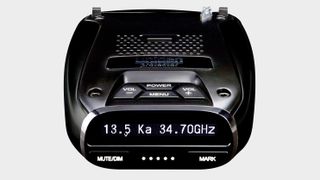
The Uniden DFR7 isn't the best-performing radar detector and it's not the easiest detector to use, but its performance stands out among radar detectors under $300. Of the four budget radar detectors we tested and reviewed, the DFR7 had the best overall performance.
It's the only detector in this price range with built-in GPS that features an over-speed alert. In the highway performance test, the DFR7 earned a B grade, which means it has plenty of range to provide you with enough time to adjust your driving speed. For example, in the straight-ahead test, it detected the radar at two miles away. With radar aimed into the rise of a hill in a road, the range was 0.85 miles. The shortest range it recorded was 0.45 miles when the radar gun was perpendicular to the road to simulate an ambush scenario.
The city performance was also above average overall, receiving a B- grade. The built-in GPS automatically muted alerts when we drove under a specific speed, which was a concern because it was too easy to forget that it was in the car. But when compared to similarly priced radar detectors, the performance was excellent.
The most practical and valuable feature is the over-speed alert, which is common among more expensive radar detectors. Using the built-in GPS to accurately measure your speed, you can set it up to alert you when you've exceeded a set speed limit. While this feature is not as easy to use as on the Escort radar detectors, it's the ideal feature for drivers that need the most protection possible. You don't have to rely on detecting radar to stay aware of your lead foot.
- Read the review: Uniden DFR7

4. Escort RedLine EX: best for highways
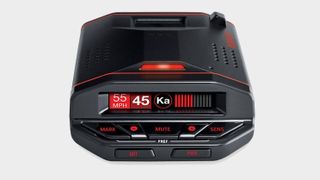
The Escort RedLine EX is a high-end radar detector built for maximum range on the highway. In our highway test, the RedLine EX had the longest range of all the radar detectors. The test consisted of aiming the radar at the road from various angles. Each detector in the test had an equal detection range in the straight-ahead test, but the EX had a longer range in the perpendicular test with the radar gun aim across the road.
The RedLine EX is also one of the easiest radar detectors to use. The controls are all front facing and clearly marked so see them from the driver's seat. You don't have to blindly feel around the top or sides of the detector for the buttons. As such, your eyes stay on the road. It also tells you exactly how fast you're driving, using the built-in GPS. So, when you receive an alert, you immediately know your speed and can adjust appropriately.
- Read the review: Escort RedLine EX

5. Valentine One: best for hobbyists
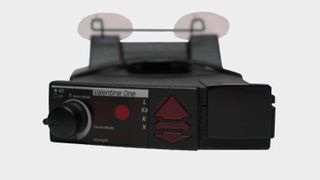
Most people buy radar detectors because they have a bad habit of getting speeding tickets. However, some merely find the technology and the challenge of detecting police fun. Among this hobbyist community, the Valentine One is the most popular radar detector, and the reason is centered on control and range.
Most radar detectors do nearly everything automatically. Some even adjust the sensitivity according to your speed using GPS. The Valentine One gives the control to the user. As such, it's not a radar detector for novices.
Another reason hobbyists are drawn to the Valentine One is the range. In our highway tests, its range was impressive, tying the RedLine EX as the longest straight-ahead range. However, the problem with this range is that it doesn't have city filters. It detects the four most common radar bands and there's no way of turning a band off. You can only adjust the sensitivity gain. Without experience and close attention to its performance, it becomes an annoying squawk box when you drive in populated areas.
- Read the review: Valentine One


- Best Car GPS Navigation Units
- Best Dash Cam
- Best Backup Camera
- Best In-dash GPS Navigation Units
- Best Car Speakers
- Best Car Alarms
- Best Car Warranty
How much do radar detectors cost?
There are three levels of radar detectors, and the pricing reflects both the level and overall performance.
While the best radar detectors are very expensive and can save you from getting expensive traffic fines, it's worth noting that driving responsibly and obeying traffic laws is free.
- Entry-level radar detectors cost between $30 and $120. These detectors are ideal if you just want something simple to help you prevent a speeding ticket.
- Midrange detectors are between $120 and $400. These detectors typically include built-in GPS with automatic sensitivity filtering.
- High-end detectors cost between $400 and $700. These are the best of the best. They have excellent displays. They're built with sturdy materials and feature super-long detection ranges, GPS, smartphone integration, Wi-Fi and more.
Radar detectors: What else you should know before you buy?
Sensitivity & False Alerts
Radar detectors have a dilemma – and it's radar. Every manufacturer aims to create a detector with the longest range, but this requires making sensors that are incredibly sensitive. Increasing the sensitivity wouldn't be such a problem if it weren't for all the other non-police radar cluttering the streets.
According to Eric Peters, an automotive columnist and contributor to the National Motorists Association, there is "more 'clutter' in the air today than ever before. Even just a decade ago, radar signals pretty much emanated only from cops and automated doors (as at grocery stores and so on). It was easier for the detector to sift through the chaff and alert you to the real deal." Now, newer cars and trucks use radar for various sensors, like blind-spot awareness, collision warning systems, and self-parking. He notes that "if you have a detector, you’ve probably noticed this. Suddenly, your unit shrieks, the warning lights go off. But where’s the cop? There's nothing around except that Escalade coming the other way."
In the U.S., radar guns are only allowed to work on three radar frequency bands – X, K, and Ka. Knowing what the alert means can help you understand whether it's likely a cop or if it's a new car. According to Peters, the Ka-band is only used by police, so if you receive a Ka alert, you should "heed it." Likewise, the X-band has a much longer wavelength, so it's typically only used for long-distance purposes, like on a highway. This is why radar detectors turn the X-band off when in city mode. Most of the time a false alert comes from the K-band, but cops also use the K-band, so you can't disregard K-band alerts either.
While we understand why many users get annoyed when their radar detectors are constantly squawking at them, it doesn’t follow that false alerts are necessarily a bad thing. Every alert, whether real or not, is a moment where you are forced to consider your driving habits. Every alert forces you to think about your speed and look around for a cop, which forces you to pay closer attention to other cars on the road. False alerts help you be a safer driver.
GPS
Most of the high-end and even most of the mid-range radar detectors have built-in GPS that automatically connects to a satellite as soon as you turn your car on. GPS has many purposes, but the primary reason it was added to radar detectors was so you could identify a false alert, such as the motion detectors at Home Depot, by locking that alert out using GPS coordinates. This is a good idea, in theory. However, Mike Valentine, creator of the Valentine One and the president of Valentine Research, Inc, makes a good point about the pitfalls of GPS systems – "GPS knows only one thing—location. And if the frequency of a new threat is near that of a blocked alarm, SORRY, but GPS demands silence at that location, even if that means silencing a trap." So, if your detector's GPS has muted the motion detector from Home Depot, and a police officer is parked nearby, the radar gun is muted as well.
Some radar detectors use GPS to mute all radar when you're driving below a specified, adjustable speed. The assumption is that you don't need to be alerted to radar if you're driving within the speed limits.
The main reason for getting a radar detector with GPS is the over-speed alert. GPS allows the radar detector to accurately measure your speed, and when you exceed a specified speed limit, it alerts you. If speeding is a habit that you want to fix, this is the best way to do it. It decreases the chances of getting a speeding ticket and doesn't rely on detecting police radar at all.
Laser Lidar Detector
A laser gun, sometimes called lidar, is another method that law enforcement uses to determine speed. Laser guns are highly accurate and very precise. While a radar gun emits radar waves that bounce all over the landscape like a flashlight, a laser gun uses an invisible beam of light. A police officer can aim a laser gun at your vehicle from over a mile away and receive an accurate and immediate reading. By the time your radar detector starts screaming at you, the officer knows your speed and has likely already decided whether or not to pull you over. Lidar sensors are not something you should ever base your purchase decision on for this reason.
The only way you can get around a lidar gun is to have a community-sharing app that alerts you to a different driver being hit with a lidar beam in the same area. But for these apps to be effective, other drivers must be using the apps in both proximity and time. These community sharing apps are not very effective, however, because there just aren’t enough drivers with radar detectors on the road and even fewer who consistently use the apps. So, the best way to avoid getting pulled over from a lidar gun is to drive within the legal speed limit.
Community Sharing Apps
Some radar detectors are heavily marketed on their community sharing app. Cobra, for example, has the Cobra iRadar app, and the Escort detectors have the Escort Live app. These community sharing apps rely on the premise that drivers can report non-radar related traffic issues, like red light cameras and speed cameras and speed traps to assist other drivers. By sharing the location, other drivers using the app are alerted to the location as they drive near it. The apps boast having over a million users, but that's peanut crumbs when you consider how many drivers are sharing the roads of America.
Radar jammers & other legal concerns
According to the Communications Act of 1934, you can legally use a radar detector so long as you aren’t a commercial truck driver. However, it is important to make sure they are legal in your state before purchasing one. In the United States, radar detectors are still illegal in Virginia and the District of Columbia and on every U.S. military base as of the time of this publication. Be considerate of local laws if you are pondering a cross-country road trip involving any of these areas. Also, individual states may have similar rules you need to follow.
In addition, it may be illegal to mount your radar detector directly onto your windshield, since it can be argued that a mounted detector blocks your line of sight as a driver. Certain states are stricter in regulating this than others and may have other conditions for mounting that must be met. It’s best to install your radar detector directly in your dash, though your sun visor may also work.
Internationally, laws and regulations regarding radar detectors vary by country and sometimes by individual provinces within a country. There are strict and lax laws around the world, so be sure to check local rules before traveling to a different country.
Radar jammers are illegal everywhere under United States federal law because they interfere with law enforcement’s ability to do its job. Although radar jammers are generally designed to be discreet, a cop can still tell if you have one if they try to detect your speed but are unable to. If a cop discovers you have a jammer, you may be ticketed and fined, and your jammer may be confiscated.
| Product | Price | Overall Rating | Performance | Controls | Alerts | Driving Awareness | Highway Performance | City Performance | Display Readability | Ease of Use | Built-In GPS | Auto-Learn | Mark Location | Front-facing Mute | Over-Speed Alert | Directional Alerts | Multiple Threat Alert | Red Light & Speed Camera Alerts | Automatic Muting |
|---|---|---|---|---|---|---|---|---|---|---|---|---|---|---|---|---|---|---|---|
| Escort Max 360c | View Deal | 5/5 | 10 | 9.8 | 10 | A+ | A | A+ | A+ | A+ | ✓ | ✓ | ✓ | - | ✓ | ✓ | ✓ | ✓ | ✓ |
| Escort RedLine EX | View Deal | 4.5/5 | 9.8 | 10 | 7 | A | A+ | A+ | A | A | ✓ | ✓ | ✓ | ✓ | ✓ | - | ✓ | ✓ | ✓ |
| Escort IX | View Deal | 4.5/5 | 9.5 | 9.5 | 7 | A | A- | A | A+ | A | ✓ | ✓ | ✓ | - | ✓ | - | ✓ | ✓ | ✓ |
| Radenso Pro M-Edition | View Deal | 3.5/5 | 8.5 | 8.5 | 3 | B+ | B | B+ | B | B- | ✓ | ✓ | ✓ | - | - | - | ✓ | ✓ | ✓ |
| Uniden DFR7 | View Deal | 3.5/5 | 8 | 7.3 | 5 | B | B | B- | B | B | ✓ | - | ✓ | ✓ | ✓ | - | - | ✓ | - |
| Radenso XP | View Deal | 3.5/5 | 8 | 8.5 | 3 | C+ | B+ | B | B+ | B- | ✓ | ✓ | ✓ | - | - | - | ✓ | ✓ | ✓ |
| Valentine One | View Deal | 3/5 | 9 | 2.8 | 5 | B+ | A+ | A | C- | C | - | - | - | ✓ | - | ✓ | ✓ | - | ✓ |
| Whistler CR93 | View Deal | 3/5 | 7.5 | 5.8 | 1 | B- | C | B- | B | C+ | ✓ | - | - | - | - | - | - | ✓ | - |
| Cobra iRAD | View Deal | 2.5/5 | 7.8 | 4 | 1 | B- | C+ | B | B+ | A- | - | - | ✓ | - | - | - | - | ✓ | - |
| Cobra RAD 450 | View Deal | 2.5/5 | 7.3 | 3.5 | Row 9 - Cell 5 | C | C+ | B | B+ | A- | - | - | - | - | - | - | - | - | - |

